Fans of Grenache Are Going to Be Thrilled with 2019 Châteauneuf-du-Pape! How Did the Vintage Turn Out So Well? (7-Bottle Pack $398) – Twelve Producers & 19 Wines
Like a great character actor in film—the bit player you recognize but can’t name—Grenache is everywhere and nowhere at once; it makes an appearance, leaves an indelible impression, then moves on. Grenache is the Paul Giamatti of grapes.
A vigorous vine, the wood of a Grenache trunk is so hardy that the varietal often grows as a bush, without the need for trellising. Likewise, irrigation is largely unnecessary, since the Grenache vines that produce the best wine grapes are under slight water stress. Capable of an exquisite reflection of terroir when yields are restricted, Grenache displays its most profound characteristics when grown in poor soils, frequently dominated by schist and sand to provide adequate drainage. In the cellar, fermentation at low temperatures is important for retaining freshness; maceration for color and tannin takes place during the early stages of fermentation, but is usually stopped before the wine becomes too tannic. New oak must be used judiciously so as not to overpower the rich fruit that is beloved by the variety’s fans, in part due to the extraordinary ripeness levels that Grenache is capable of reaching in warm climates.
Once the most widely planted red wine grape on earth, many Grenache vines were uprooted in recent years—part of the European government’s effort to decrease the amount of inexpensive wine made from unchecked, high-yielding vines. In Spain and Southern Australia, it is enjoying a renaissance, while in France, Grenache remains one of the most important red wine grapes of the Languedoc. Grenache/Syrah/Mourvèdre is still regarded as the holy trinity in southern Rhône’s best red wines: Châteauneuf-du-Pape, Gigondas, Vacqueyras, Lirac and Tavel.
How Did the 2019 Vintage Turn Out So Well?
Unlike the previous two growing seasons, 2019 came in like a lamb and left behind a lion’s share of superb Châteauneuf-du-Pape. Moderate temperatures throughout the winter and no killing frosts in the early spring ensured an abundant fruit set. Three heat waves followed, each interspersed with rain and more moderate temperatures, and as a result, there was no drought stress for the vines, and ripening never shut down for a significant period.
Harvest was prolonged and allowed growers to pick at what they felt was the optimum ripeness. As difficult as 2017 and 2018 had been, 2019 was a dream vintage; virtually nothing had to be done in the vineyard. The health of the harvest carried through to the cellar, with many growers reporting that their vinification, mostly done on indigenous yeast, was fast and efficient. The only challenge, as it happens, was tannin management, but for Grenache in particular, 2019 was an ideal vintage.
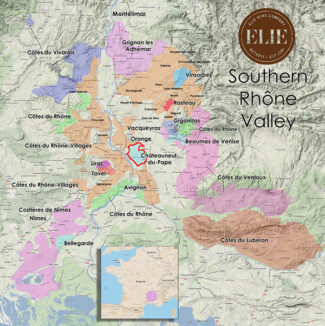
Châteauneuf-du-Pape:
A Peak Expression of the Southern Rhône
The best, and by most accounts, the most reliable of the many Southern Rhône labels is the insignia-embossed Châteauneuf-du-Pape, which hails from a remarkable region between the towns of Orange and Avignon. Named for the castle built by the 14th Century Pope John XXII, this heavily-extracted wine is the template after which most Côtes du Rhône reds model themselves. In fact, it’s these copycats that persuaded the producers of genuine Châteauneuf-du-Pape producers to apply to the French government to protect their name, making it the first AOP in France.
The unique combination of precipitation (Châteauneuf-du-Pape is very dry) and wind (the powerful mistral blows in from the Gulf of Lion in the northern Mediterranean) and especially, the large, flat stones known as galets roulés which serve to prevent surface evaporation and reflect sunlight into the canopy, is the appellation’s secret. This happens to be conditions ideal for Grenache to realize full potential, and as a result, Châteauneuf-du-Pape is largely built around this grape. Syrah adds black-fruit spice, and is grown on cooler higher ground; Mourvèdre brings flesh and acidity, and makes up about 10% of a typical blend. To a decreasing extent, Cinsault is used for aromatics; a total of 13 varietals are permitted, giving the wine a legendary and almost unrivaled complexity.
Taste and Character
Big-shouldered and occasionally blustery, Châteauneuf-du-Pape wine may, in ideal vintages as in 2019, be as enjoyable to drink in its youth as it is with age. When young, a core of perfumed fruit tames the tannins and acidity, and tempers into rich leather and smoky, earth-tones as it grows older.
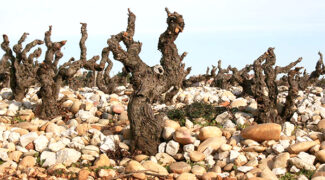
Untrained Old Vines Grenache Bush in Galets Roulés
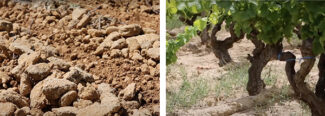
Grès Rouge, Sand and Safre
Terroir and Soil
Châteauneuf-du-Pape terroir has origins 60 million years ago, when a shallow primeval sea flooded the Rhône Valley. As it receded, it left behind ‘safre’ (an aggregate of sandy sediment) and banks of clay and limestone. Four ice ages punctuated by warm interglacial period accounts for the terraces visible in Châteauneuf-du-Pape as well as the heterogeneous soil. In general, soils in the rocky, western sectors of Châteauneuf-du-Pape are formed of limestone, while sand and clay soils covered with large stones dominate the plateaus. Mixed sand, red and grey clay and limestone can be found in the northern part of the appellation and less stony soil alternating with marl in the east, while shallow sand and clay soil on a well-drained layer of gravel dominate the south.
Weather and Climate
Located within the Vaucluse department, Châteauneuf-du-Pape has a Mediterranean climate—the type found throughout much of France’s south—and characterized by hot, dry summers and cool, wet winters. It rarely snows at sea level (as opposed to the surrounding mountains, where snowfall may be considerable.)
As the equal of elevation and rainfall, a third defining feature of the climate in Southern France is the wind. In a land dominated by hills and valleys, it is always windy—so much so that in Provence, there are names for 32 individual winds that blow at various times of year, and from a multitude of directions. The easterly levant brings humidity from the Mediterranean while the southerly marin is a wet and cloudy wind from the Gulf. The mistral winds are the fiercest of all and may bring wind speeds exceeding 60 mph. This phenomenon, blowing in from the northeast, dries the air and disperses the clouds, eliminating viruses and excessive water after a rainfall, which prevents fungal diseases.
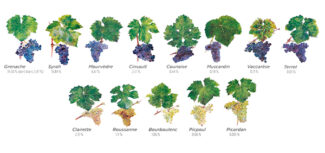
Vineyard Management and Grapes
In 1936, the Institut National des Appellations l’Origine officially created the Châteauneuf-du-Pape appellation, with laws and rules that growers and vignerons were required to follow. It was agreed that the appellation would be created based primarily on terroir (and to a lesser extent, on geography) and includes vines planted in Châteauneuf-du-Pape and some areas of Orange, Courthézon, Sorgues and Bédarrides. 15 grape varieties are allowed in the appellation: Grenache, Syrah, Mourvèdre, Terret Noir, Counoise, Muscardin, Vaccarèse, Picardan, Cinsault, Clairette, Roussanne, Bourboulenc, Red Picpoul, White Grenache and White Picpoul. Vine density must not be less than 2,500 vines per hectare and cannot exceed 3,000 vines per hectare. Vines must be at least 4 years of age to be included in the wine. Machine harvesting is not allowed in Châteauneuf-du-Pape, so all growers must harvest 100% of their fruit by hand.
Beyond that, vines are allowed to be irrigated no more than twice a year. However, irrigation is only allowed when a vintage is clearly suffering due to a severe drought. If a property wishes to irrigate due to drought, they must apply for permission from the INAO, and any watering must take place before August 15.
Traditional and Modern Styles
Throughout much of its history, CdP provided a leathery foil to the potent and somewhat austere elegance of Bordeaux and the heady sensuousness of Burgundy. CdP is ‘southern wine’, filled with rustic complexity—brawny, earthy and beautiful. But as a business, all wine finds itself beholden to trends, since moving product is necessary to remain afloat. During the Dark Ages (roughly1990 through 2010—in part influenced by the preferences of powerful critic Robert Parker Jr.) much of Châteauneuf-du-Pape’s output became bandwagon wines, jammy and alcoholic, lacking structure and tannin, in the process becoming more polished than rustic and more lush than nuanced. For some, this was delightful; for others, it was a betrayal of heritage and terroir.
These days, a new generation of winemakers seem to have identified the problem and corrected it. Recent vintages—2019 in particular—have seen the re-emergence of the classic, balanced style Châteauneuf-du-Pape, albeit at slightly higher prices. A changing climate has also altered traditional blends, so that more Mourvèdre may be found in cuvées that were once nearly all Grenache. Mourvèdre tends to have less sugar and so, produces wine that is less alcoholic and jammy, adding back some of the herbal qualities once so highly prized in the appellation. But a return to old school technique has also helped; many of the wines in this package were not destemmed prior to crushing and most were fermented on native yeast rather than cultured yeast.
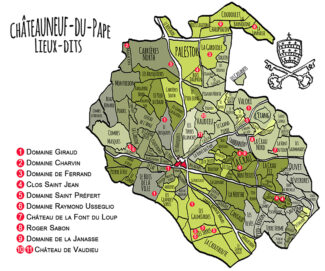
This week’s package is comprised of one of each of the following seven wines for $398. The rest of the wines on the list are offered at special prices for your consideration to add to package purchase, or buy separately.
Domaine Giraud
The estate may be considered the love-child of Pierre and Mireille Giraud, the union of two venerable wine families. Pierre Giraud can trace his winemaking roots back six centuries while Mireille Buou’s family owned a village distillery for several generations. In 1974, the couple began to cultivate ten acres as sharecroppers, and over the course of a dozen years, acquired local land. In 1981, they transformed the Buou distillery into a winemaking operation, and first released a bottling under the name Domaine Giraud.
Among their plots, Pierre and Mireille inherited twenty acres of century-old vines located on the plateau of La Crau, Les Galimardes and on the sandy soils of the Pignan area near the Le Rayas district. In 1998, the couple turned the everyday administration of the domain to their children, Marie and François, both with degrees in viticulture and oenology. The work of plot selection as well as a transition to organic farming is now tasked to the new generation.
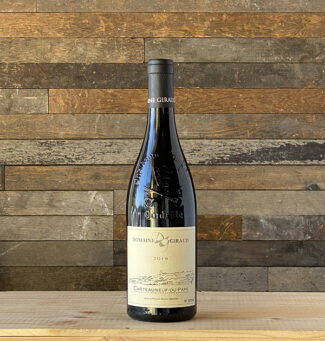 Domaine Giraud ‘Tradition’, Châteauneuf-du-Pape 2019 ($55)
Domaine Giraud ‘Tradition’, Châteauneuf-du-Pape 2019 ($55)
Red from red: Grenache, Syrah, Mourvèdre grown among the galets in the red clay soils of southern Châteauneuf-du-Pape. The vines, from the Bois de la Ville, la Cerise, les Galimardes, le Tresquoys and Valori lieux-dits, are between 60 and 85 years old, each certified organic. The blend is nearly 60% Grenache followed by Syrah and small amount of Mourvèdre fermented separately; the Syrah in French oak barrels with the Mourvèdre and Grenache in stainless steel and concrete. The wine shows cherry liqueur and lavender flavors with Provençal herbs, licorice, and loamy earth. The tannins are polished and the finish long and complex.
Domaine Charvin
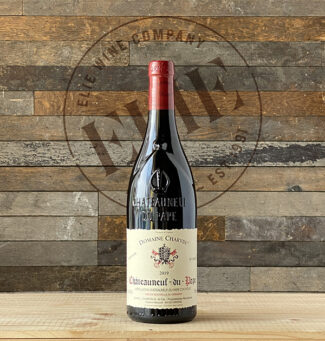 Established in 1851, Domaine Charvin is currently owned and operated by Laurent, the sixth-generation Charvin to run the domain but the first to commercially market a proprietary bottling. His meticulous attention to detail sees his harvest entirely hand-picked and sorted and bottled without filtration. Charvin produces only a single cuvée of Châteauneuf-du-Pape, which is consistently rated highly; it’s drawn from a 20-acre plot composed of vines whose average age is over fifty years, mostly planted on sandy, north-facing slopes.
Established in 1851, Domaine Charvin is currently owned and operated by Laurent, the sixth-generation Charvin to run the domain but the first to commercially market a proprietary bottling. His meticulous attention to detail sees his harvest entirely hand-picked and sorted and bottled without filtration. Charvin produces only a single cuvée of Châteauneuf-du-Pape, which is consistently rated highly; it’s drawn from a 20-acre plot composed of vines whose average age is over fifty years, mostly planted on sandy, north-facing slopes.
Domaine de Ferrand
Philippe Bravay is one of CdP’s most vocal cheerleaders and walks the walk just as well. From his 18-acre property, spread over six parcels in four lieux-dits, he draws half his juice from vines over 45 years old and the other half from vines that have hit the century mark. He is dedicated not only to Southern Rhône, but to organic farming and limited yields—his Côtes-du-Rhône harvests 2.5 tons per acre and his Châteauneuf-du-Pape even less. His vinification philosophy is the same for all his wines: “I do not use barriques because I want the wine of my vines and not a technical élevage which loses the origins of the wine. There is no filtration, only one fining for each wine. During the aging, the wine is neither racked nor blended, which is done only at the time of bottling and without the addition of preservatives.”
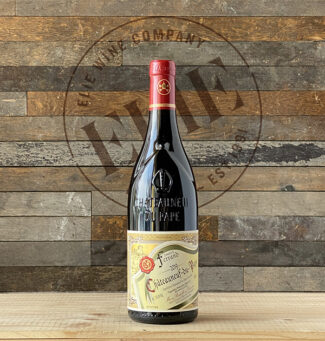 Domaine de Ferrand, Châteauneuf-du-Pape 2019 ($61)
Domaine de Ferrand, Châteauneuf-du-Pape 2019 ($61)
90% Grenache, 8% Syrah and 2% Mourvèdre from vines whose age averages 75 years. Lieux-dits that contribute to this wine include La Gardiole and Cabrières vineyards and notably, La Guariguette and Les Jaumes, which were planted in 1904, 1910 and 1920. The wine is concentrated but light on its feet with notes of violet, Asian spices, Bing cherry and smoke behind moderate acidity and ripe tannins—in short, it displays all the richness of the 2019 vintage.
Clos Saint Jean
An example of the oldest and the newest in CdP—the cellar originated in 1900, 23 years before the AOP of Châteauneuf-du-Pape was created, yet current owners Vincent and Pascal Maurel are considered prime proponents of the ‘modern style’ of winemaking in Châteauneuf. Clos Saint-Jean is a hundred-acre estate, with 60% of the vineyards located on iconic plateau of La Crau, primarily in the lieux-dits of Côteau de Saint-Jean and Cabane de Saint-Jean, where iron-rich red clays are topped with galets. Another 40% are located in alluvial clay and sandy soils adjacent to the plateau. They also own a small parcel of Mourvèdre in the lieu-dit of Bois-Dauphin near Château Rayas planted on sandy, limestone-rich soils.
The Maurels are dedicated to sustainable agriculture, a philosophy made easier in Châteauneuf since the warm, dry climate prevents the need for chemical applications. For pest control, they use natural pheromones, vines, a process called in French ‘confusion sexuelle’ (!)
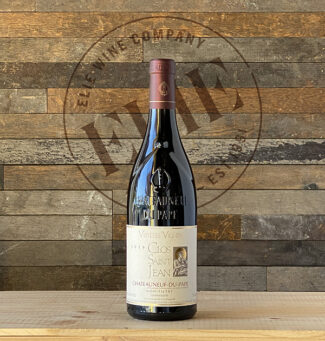 Clos Saint Jean ‘Vieilles Vignes’, Châteauneuf-du-Pape 2019 ($55)
Clos Saint Jean ‘Vieilles Vignes’, Châteauneuf-du-Pape 2019 ($55)
A bigger, badder version of the classic cuvée (Grenache, Syrah, Mourvèdre, Cinsault, Vaccarèse and Muscardin) with darker fruits and more pronounced notes of chocolate and spices behind the intoxicating scents of ripe plums, kirsch and licorice.
Domaine Saint Préfert
Isabel Ferrando is the force behind Saint Préfert and one of the most respected winemakers in France; her reputation has grown every vintage since her first release in 2003. From the 55-acre estate in the south of CdP, she produces five cuvées, two whites and three reds. The vines are old, but her team is young and she is always open to new ideas; she relies on tradition without being trapped by it. For example, she has taken to Stockinger as a supplier of oak for maturation, claiming that the Austrian cooperage results in more tension in the wines. In the 2009 vintage, Ferrando started working with whole-cluster fermentation without added yeasts, and discovered that this magnified freshness in the wines. “In ten years,” she maintains, “I’ve progressed. My sensitivity to the terroir is much more pronounced.”
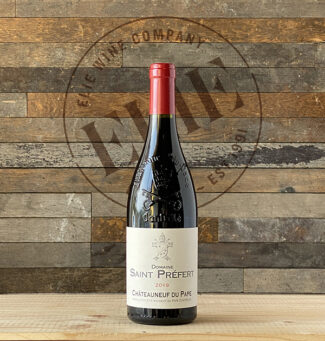 Domaine Saint Préfert ‘Classique’, Châteauneuf-du-Pape 2019 ($52)
Domaine Saint Préfert ‘Classique’, Châteauneuf-du-Pape 2019 ($52)
85% Grenache and 5% each of Syrah, Mourvèdre, and Cinsault. Vinified from middle-aged vines -30 years, tops- and aged entirely in concrete tanks; a beautifully perfumed and nuanced wine with classic notes of strawberries, cherries, loam and dried flowers; polished, elegant and silky on the palate.
Domaine Raymond Usseglio
Domaine Raymond Usseglio should not be confused with Domaine Pierre Usseglio, owned by his brother as a continuation of the winery founded by their father Francis. Raymond’s son Stéphane Usseglio has now taken over the reins, and is pushing to reach the potential of some of best holdings in the appellation. About half of the 45-acre domain consists of 60-year-old vines in the famous La Crau vineyard; the other half climbs the hill across the road from the actual ruins of the castle from which Châteauneuf-du-Pape gets its name.
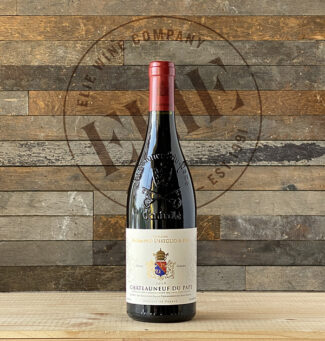 Raymond Usseglio ‘Girard’, Châteauneuf-du-Pape 2019 ($50)
Raymond Usseglio ‘Girard’, Châteauneuf-du-Pape 2019 ($50)
Bottled exclusively for the American market, ‘Girard’ is 85% old-vine Grenache (average age, 80 years) blended with Mourvèdre, Cinsault and Counoise grown in sandy soil with galets on red clay marl. The wine shows rich dark fruit (blackcurrant especially) with white pepper notes behind the characteristic garrigue aromas of bay leaf and rosemary.
Château de la Font du Loup
La Font du Loup translates to ‘Fountain of the Wolves’, a reference to the wolves who once sought water in the natural springs here. In 1942, the land was purchased by Charles Melia, a grower who sold exclusively to négociants. It was not until 1979 that his descendants began bottling under their own label.
Today, the estate is managed by Charles Melia’s daughter Anne-Charlotte and her husband Laurent Bachas; they have purchased additional acres, including ten acres of old-vine Grenache in the lieu-dit Le Puy-Roland. Vineyards are fully organic and planted mostly to red varieties, although the estate produces a singly bottling of Châteauneuf-du-Pape Blanc made from Grenache Blanc, Roussanne, Clairette and Bourboulenc.
The fifty acres of Château de la Font are situated on the highest plateau in the appellation, and harvest takes place about a week later than the rest of CdP.
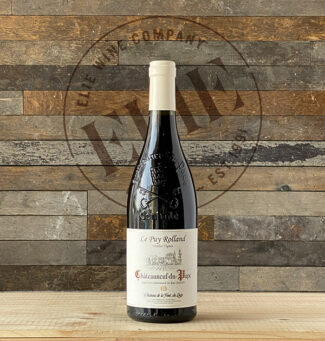 Château de la Font du Loup ‘Le Puy Rolland Vieilles Vignes’, Châteauneuf-du-Pape 2019 ($59)
Château de la Font du Loup ‘Le Puy Rolland Vieilles Vignes’, Châteauneuf-du-Pape 2019 ($59)
100% Grenache from vines 100 years old. The soils of ‘Le Puy Rolland’ lieu-dit are predominantly sand, and Grenache grown in such soils are unique in character, more elegant and with slightly less alcohol with ripe, spice-accented red and blue fruit scents sharpened by smoky minerality. Adding to the striking profile of the wine, ‘Le Puy Rolland’ is composed of north-facing plots which ripen even more slowly than the rest of the château’s vines and the harvest happens two weeks later than many Châteauneuf-du-Pape estates. Around 1,500 cases are produced annually.
… Add from the following
Roger Sabon
Founded in 1952, Domaine Roger Sabon is currently run by Roger’s sons Denis and Gilbert, with Didier Negron serving as winemaker. Having grown slowly since inception, the domain now covers 50 acres in Châteauneuf-du-Pape, 20 in Lirac and 20 in Côtes-du-Rhône. Most of their Châteauneuf-du-Pape vineyards are located in the northeastern part of the appellation, where the soils are sandier with a high concentration of limestone. They also own a few parcels in Le Crau, famous for its red clay under a deep layer of galets. Their most prized vines, over 100 years old, are located in two plots near Courthézon. These are the source for the 100-point ‘Secret des Sabon’ 2019.
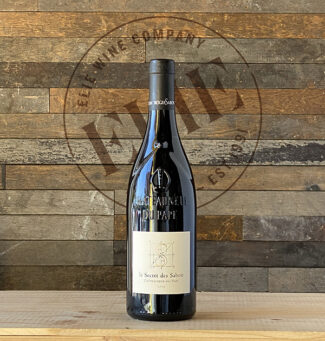 Roger Sabon ‘Le Secret des Sabon’, Châteauneuf-du-Pape 2019 ($216)
Roger Sabon ‘Le Secret des Sabon’, Châteauneuf-du-Pape 2019 ($216)
‘Le Secret des Sabon’ began as an experiment that evolved into of the Sabon’s top bottlings. As befits the enigmatic name, not much technical information is released about the cuvée, but it may presume to arise from very old Grenache with very low yields; only a single demi-muid is produced each year, corresponding to about 160 gallons. The wine shows more refinement than weight, with red fruit dominating mineral and herb accents.
Domaine de la Janasse
Siblings Christophe and Isabelle Sabon have found their Holy Grail in Southern Rhône, using both traditional and modern techniques to craft outstanding wines from value-priced Vins de Pays to their benchmark Châteauneuf-du-Pape. While the brother and sister work the cellar, their father oversees the vineyards, scattered about the appellation in 70 parcels, where terroirs range from sandy soils in the north—Chapouin and La Janasse—to the lightly-colored clay-limestone soils and gravelly red clay and galets of La Crau.
Janasse wines are often described as ‘earthy’, in part the result of cellar technique. The grapes are not entirely destemmed and undergo long, gentle macerations lasting up to a month. Afterward, aging takes place in various vessels, from large concrete tanks to foudres and demi-muids. The barrels are mostly neutral, darkened with age and repeated use.
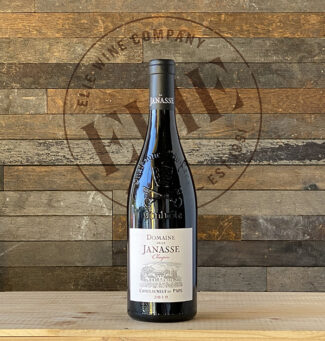 Domaine de la Janasse ‘Chaupin’, Châteauneuf-du-Pape 2019 ($85)
Domaine de la Janasse ‘Chaupin’, Châteauneuf-du-Pape 2019 ($85)
100% old-vine Grenache intended to showcase the purity and energy that these vines are capable of achieving in the sandy soils of Sabon’s lieu-dit ‘Chapouin.’ Since the first bottling in 1990, the cuvée has expanded to include Grenache from the similar terroirs of La Janasse and Le Crau. The wine has a salty cranberry tang lifting the sweet, soft cherry notes, with Provençal garrigue, tea leaves and a long, tannic finish.
Domaine Raymond Usseglio
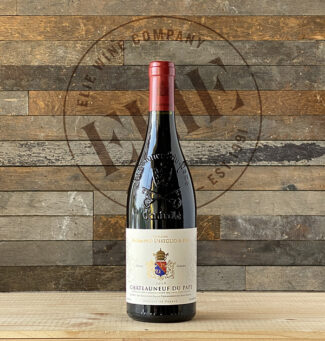 Domaine Raymond Usseglio ‘Impériale Vignes Centenaires’, Châteauneuf-du-Pape 2019 ($82): 95% Grenache from La Crau vines that are more than a century old, the wine shows bright scents of roses, black tea and raspberries while the palate is expansive but silky, delivering an intricate interplay of red fruit, dried spices and orange zest.
Domaine Raymond Usseglio ‘Impériale Vignes Centenaires’, Châteauneuf-du-Pape 2019 ($82): 95% Grenache from La Crau vines that are more than a century old, the wine shows bright scents of roses, black tea and raspberries while the palate is expansive but silky, delivering an intricate interplay of red fruit, dried spices and orange zest.
Domaine de Beaurenard
Domaine de Beaurenard has been a family-affair for eight generations; the current gang includes brothers Daniel & Frédéric Coulon and Daniel’s sons Victor and Antonin. Domaine de Beaurenard has been producing certified biodynamic wines on more than 80 acres of this celebrated terroir since 2010. As Châteauneuf-du-Pape is characterized by the diversity of its soils with a mosaic of vineyards where different varieties grow together, the Coulon family has carefully assembled a ‘collection plot’ of all the allowable CdP grapes; between 1998 and 2005, the best strains of Domaine de Beaurenard’s old vines were carefully selected, and in 2006, the rootstocks were planted. Today, it is a mixed varietal vineyard with the various cultivars interspersed and worked by hand and by horse.
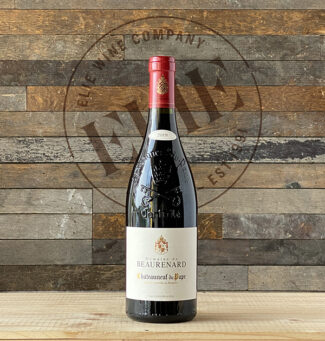 Domaine de Beaurenard, Châteauneuf-du-Pape 2019 ($89)
Domaine de Beaurenard, Châteauneuf-du-Pape 2019 ($89)
65% Grenache, 15% Syrah, 10% Mourvèdre, and the rest a field blend. The domain’s flagship wine is vibrant and fresh with classic notes of black raspberry and black cherry as well as peppery herbs, violets, spring flowers and sous bois.
Château de la Font du Loup
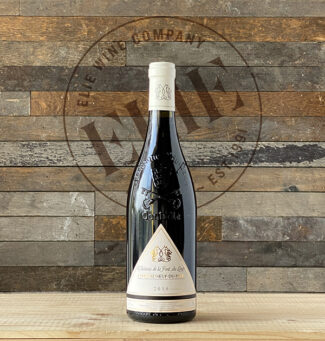 Château de la Font du Loup, Châteauneuf-du-Pape 2019 ($51)
Château de la Font du Loup, Châteauneuf-du-Pape 2019 ($51)
60% Grenache, 20% Mourvèdre, 15% Syrah, and 5% Cinsault from a lieu-dit named after the estate; La Font du Loup is a high, north-facing plot just east of La Crau. 2019 produced a massive, jammy wine with loads of raspberry and strawberry on the nose and a palate rounded out by herbs—thyme and mint especially—and nicely integrated tannins. Aged one year in oak foudres and three more in cement tanks. 2000 cases produced.
Château de Vaudieu
Dominated by a classic château built in 1767, Vaudieu is not only one of the oldest wineries in Southern Rhône, but it was the first to export its wine to other markets. Once the largest vineyards in the region, by the time the Maffre family purchased it (1955), the estate had been reduced to around 60 acres. A series of renovations and purchases, Gabriel Maffre expanded the holdings to its current 175 acres, planted mostly to red varietals, although all 13 allowable grapes are grown somewhere on the property.
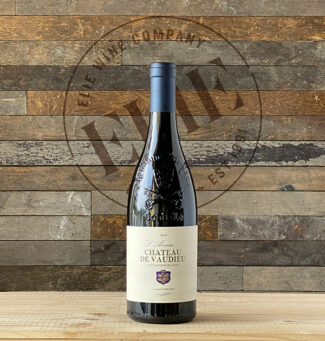 Château de Vaudieu ‘L’Avenue…’, Châteauneuf-du-Pape 2019 ($126)
Château de Vaudieu ‘L’Avenue…’, Châteauneuf-du-Pape 2019 ($126)
100% Grenache from the Vaudieu lieu-dit, where a typical terroir of rocks, clay and sandy soil is ideal for this variety. The wine shows acacia flowers, kirsch, lavender, wild herbs and plums and a racy, expansive finish.
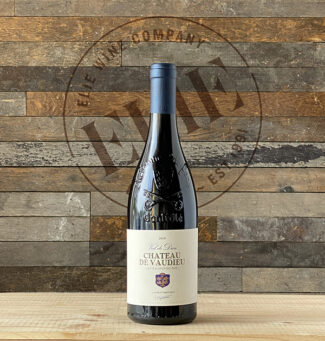 Château de Vaudieu ‘Val de Dieu’, Châteauneuf-du-Pape 2019 ($89)
Château de Vaudieu ‘Val de Dieu’, Châteauneuf-du-Pape 2019 ($89)
A blend of 60% old-vine Grenache with 25% Syrah and 15% Mourvèdre. The lieu-dit ‘Val de Dieu’ begins near the entrance to the Vaudieu property, where the heavier sandy clay is more drought resistant and best suited to Mourvèdre. It continues up a gentle rise where sandy limestone soils are planted to Syrah before cresting a gentle hill of decomposed sandstone soils that is ideal for Grenache. The wine shows creamy raspberry, boysenberry and blackberry fruit atop a polished structure, while anise, bergamot, fruitcake and cinnamon notes filter through on the finish.
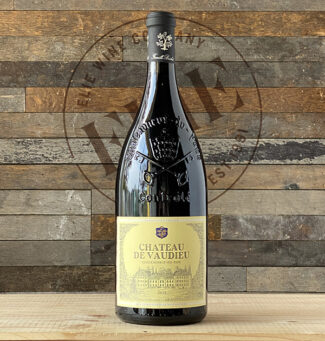 Château de Vaudieu, Châteauneuf-du-Pape 2019, Magnum ($117)
Château de Vaudieu, Châteauneuf-du-Pape 2019, Magnum ($117)
58% Grenache, 25% Syrah, 11% Mourvèdre and the rest Cinsault; the nose reveals a lively blend of strawberry and fresh cocoa, followed by notes of white pepper. The palate evolves into beautiful concentration of menthol tannins and finishes with notes of graphite.
Domaine Saint Préfert
If a Grenachiste is a loyalist who fights for Grenache, it would be hard to find a High Priestess more qualified than Isabel Ferrando. Her ever-growing expertise and hands-on winemaking produces an outstanding portfolio. The following are her special cuvées.
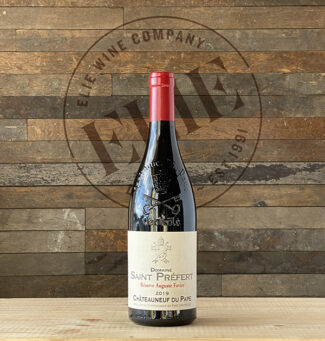 Domaine Saint Préfert ‘Auguste Favier’, Châteauneuf-du-Pape 2019 ($80)
Domaine Saint Préfert ‘Auguste Favier’, Châteauneuf-du-Pape 2019 ($80)
85% Grenache and 15% Cinsault from the Les Serres lieu-dit, the grapes are handpicked and vinified separately; the Grenache is aged in cement and the Cinsault in 600-liter barrels. The power and grace of this wine extends from the core of cassis and cherry purée to light leather, red licorice and violet notes that lead to a silky finish.
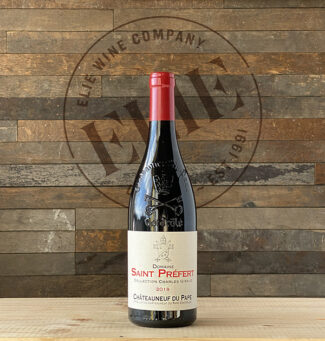 Domaine Saint Préfert ‘Collection Charles Giraud’, Châteauneuf-du-Pape 2019 ($159)
Domaine Saint Préfert ‘Collection Charles Giraud’, Châteauneuf-du-Pape 2019 ($159)
60% Grenache and 40% Mourvèdre; the high percentage of Mourvèdre shows concentrated black raspberry, boysenberry, violet pastille and fruitcake flavors. 2019 will be the last wine under the Domaine Saint-Préfert label; going forward, the wines will be under the Domaine Isabel Ferrando label. In addition, both special cuvées of Reserve Auguste Favier and Collection Charles Giraud will be discontinued in favor of a single Châteauneuf du Pape cuvée (à la Clos des Papes) that will include all the estate terroirs.
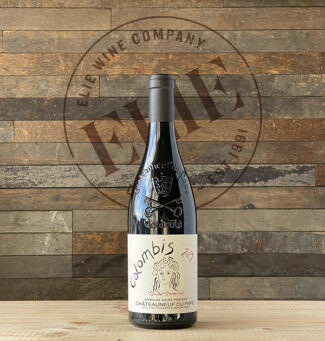 Domaine Saint Préfert Isabel Ferrando ‘Colombis’, Châteauneuf-du-Pape 2019 ($159)
Domaine Saint Préfert Isabel Ferrando ‘Colombis’, Châteauneuf-du-Pape 2019 ($159)
100% old-vine Grenache from the Colombis lieu-dit, located on the western side of the appellation. A classic Grenache bouquet of black raspberries, herbs de Provence, peppery spice and flowery incense.
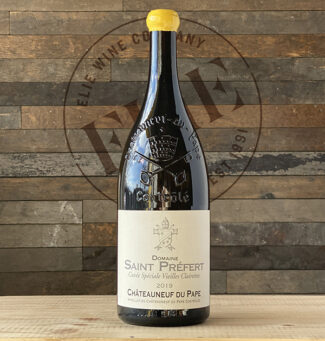 Domaine Saint Préfert ‘Cuvée Spéciale Vieilles Clairettes’ Châteauneuf-du-Pape Blanc 2019 ($432) Magnum
Domaine Saint Préfert ‘Cuvée Spéciale Vieilles Clairettes’ Châteauneuf-du-Pape Blanc 2019 ($432) Magnum
The inspiration for this wine came from a 1947 bottle of Henri Bonneau’s Vieilles Clairettes. With advice from Bonneau, a CdP legend, Isabel Ferrando determined that she could make a similar wine from the rare pink Clairette she had co-planted in her vineyards. Bottled only in magnums as a ‘special occasion’ wine, it is 100% Clairette Rose from 80-100-year-old vines in Les Serres lieu-dit. Flavor notes include pink grapefruit, rose water, melon, lemon curd and macadamia nut notes wrapped in a flurry of chamomile, acacia and warm brioche.
- - -
Posted on 2022.05.23 in Châteauneuf-du-Pape, France, Wine-Aid Packages, Southern Rhone
Featured Wines
- Notebook: A’Boudt Town
- Saturday Sips Wines
- Saturday Sips Review Club
- The Champagne Society
- Wine-Aid Packages
Wine Regions
Grape Varieties
Aglianico, Albarino, Albarín Blanco, Albarín Tinto, Albillo, Aleatico, Arbanne, Aubun, Barbarossa, barbera, Beaune, Biancu Gentile, bourboulenc, Cabernet Franc, Cabernet Sauvignon, Caino, Caladoc, Calvi, Carcajolu-Neru, Carignan, Chablis, Chardonnay, Chasselas, Clairette, Corvina, Cot, Counoise, Erbamat, Ferrol, Fiano, Frappato, Friulano, Fromenteau, Fumin, Garnacha, Gewurztraminer, Godello, Graciano, Grenache, Grolleau, Groppello, Juan Garcia, Lambrusco, Loureira, Macabeo, Macabou, Malvasia, Malvasia Nera, Marsanne, Marselan, Marzemino, Melon de Bourgogne, Merlot, Mondeuse, Montanaccia, Montepulciano, Morescola, Morescono, Moscatell, Muscadelle, Muscat, Natural, Nero d'Avola, Parellada, Patrimonio, Petit Meslier, Petit Verdot, Pineau d'Aunis, Pinot Auxerrois, Pinot Blanc, Pinot Gris, Pinot Meunier, Pinot Noir, Poulsard, Prieto Picudo, Rondinella, Rousanne, Roussanne, Sangiovese, Sauvignon Blanc, Savignin, Semillon, Souson, Sparkling, Sumoll, Sylvaner, Syrah, Tannat, Tempranillo, Trebbiano, Trebbiano Valtenesi, Treixadura, Trousseau, Ugni Blanc, vaccarèse, Verdicchio, Vermentino, Viognier, Viura, Xarel-loWines & Events by Date
- April 2024
- March 2024
- February 2024
- January 2024
- December 2023
- November 2023
- October 2023
- September 2023
- August 2023
- July 2023
- June 2023
- May 2023
- April 2023
- March 2023
- February 2023
- January 2023
- December 2022
- November 2022
- October 2022
- September 2022
- August 2022
- July 2022
- June 2022
- May 2022
- April 2022
- March 2022
- February 2022
- January 2022
- December 2021
- November 2021
- October 2021
- September 2021
- August 2021
- July 2021
- June 2021
- May 2021
- April 2021
- March 2021
- February 2021
- January 2021
- December 2020
- November 2020
- October 2020
- September 2020
- August 2020
- July 2020
- June 2020
- May 2020
- April 2020
- March 2020
- February 2020
- January 2020
- December 2019
- November 2019
- October 2019
- September 2019
- August 2019
- July 2019
- June 2019
- May 2019
- April 2019
- March 2019
- February 2019
- January 2019
- December 2018
- November 2018
- October 2018
- September 2018
- August 2018
- July 2018
- June 2018
- May 2018
- April 2018
- March 2018
- February 2018
- January 2018
- December 2017
- November 2017
- October 2017
- September 2017
- August 2017
- July 2017
- June 2017
- May 2017
- April 2017
- March 2017
- February 2017
- January 2017
- December 2016
- November 2016
- October 2016
- September 2016
- August 2016
- July 2016
- June 2016
- May 2016
- April 2016
- March 2016
- February 2016
- January 2016
- December 2015
- November 2015
- October 2015
- September 2015
- August 2015
- July 2015
- June 2015
- May 2015
- April 2015
- March 2015
- February 2015
- January 2015
- December 2014
- November 2014
- October 2014
- September 2014
- August 2014
- July 2014
- June 2014
- April 2014
- March 2014
- February 2014
- January 2014
- December 2013
- November 2013
- October 2013
- September 2013
- August 2013
- July 2013
- June 2013
- May 2013
- April 2013
- March 2013
- February 2013
- January 2013
- December 2012
- November 2012
- October 2012
- February 2004
Search



